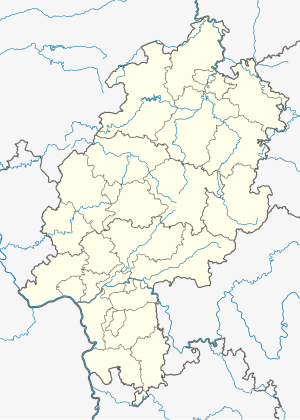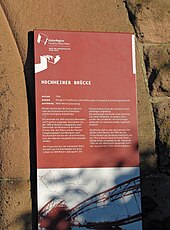Hochheim railway bridge
Coordinates: 49 ° 59 ′ 59 ″ N , 8 ° 20 ′ 21 ″ E
| Hochheim railway bridge | ||
|---|---|---|
| The Hochheim railway bridge from the west, behind it the Hochheim motorway bridge of the A 671 | ||
| use | Railway bridge | |
| Convicted | Mainz bypass | |
| Subjugated | Main | |
| place | Hochheim , Bischofsheim | |
| Entertained by | DB Netz AG | |
| Building number | 105730 | |
| construction | Arch bridge | |
| overall length | 561 m | |
| width | 8.65 m | |
| Longest span | 2 × 82.60 m | |
| Construction height | 15.25 m | |
| Headroom | 7.85 m (lock) | |
| start of building | 1901 | |
| completion | 1904 | |
| opening | May 2, 1904 | |
| location | ||
|
|
||
The Hochheim Railway Bridge (also known as Kostheim Bridge ) is a double-track railway bridge between the southern Hessian towns of Hochheim am Main and Gustavsburg , which spans the Main at river kilometer 3,530 . The structure lies between the route kilometers 10.338 and 10.899 and, together with the Kaiserbrücke, forms part of the electrified Mainz bypass . The bridge is a cultural monument according to the Hessian Monument Protection Act .
designation
Different names can be used for the structure. The name Hochheimer Brücke is on an information board on the southern foreland bridge, which was attached as part of the route of industrial culture Rhine-Main . Contrary to this, Kostheimer Brücke is used in the literature . The reason given is the primacy of Kostheim , although the northern bridgehead is in the Hochheim district, while in the south the bridge ends in the Bischofsheim district and leads to the Mainz-Bischofsheim train station .
Between Mainz-Kostheim and Ginsheim-Gustavsburg there is a road bridge that crosses the Main and is also known as the Kostheim Bridge .
history
The steel framework - arched bridge was built in 1902–1904 by the Prussian-Hessian Railway Association for the Mainz bypass line and put into operation on May 2, 1904. With its construction and the simultaneous commissioning of the Mainz Kaiserbrücke , which also belongs to the bypass railway , the Mainz main station was significantly relieved.
For the steel superstructures, a type of construction was used, which Duisburger AG for iron industry and bridge construction proposed. Johann Caspar Harkort had already developed it in 1894, and which was used in a number of railway bridges in Germany until the beginning of the First World War. The MAN bridge construction company in Gustavsburg was commissioned with the manufacture and assembly of the superstructures . In 1909, a block was built between the Kostheim depot and the Bischofsheim station on the bridge , which was named the Mainbrücke block .
Towards the end of the Second World War, the bridge was blown up by the Wehrmacht in 1945 . After the end of the war it was largely rebuilt and put back into operation in 1947.
The structure connects the so-called Taunusbahn between Frankfurt am Main and Wiesbaden on the north side of the Main with the Hessian Ludwigsbahn , between Mainz , Darmstadt and Aschaffenburg and the Mainbahn from Bischofsheim to Frankfurt am Main on the south side of the Main.
construction
The 561 meter long structure consists of a steel river bridge and bricked, arched foreshore bridges on both sides . The river bridge spans the Main over a length of 293 meters . It consists of four double-track superstructures, which are designed as arched truss girders with a drawstring and have slightly different lengths, the longest measuring 82 meters. The rail level is suspended from them. Red sandstone pillars support the superstructures. The abutments at both ends of the bridge were also built from this material , which, with their bundled, tower-like structures in Romanesque Art Nouveau, developed a monumental effect. Due to the construction time, the large forms of the bridge are designed in the neo-Romanesque style, numerous details in Art Nouveau, such as B. the bridge railings. Much of this original design has been preserved.
literature
- State Office for Monument Preservation Hessen (Ed.), Heinz Schomann: Railway in Hessen. (= Monument topography Federal Republic of Germany , cultural monuments in Hesse . ) Edition Henrich, Frankfurt am Main 2005, ISBN 3-8062-1917-6 , Volume 2, Part 2, pp. 893 f.
Web links
- State Office for Monument Preservation Hessen (Ed.): Eisenbahnbrücke In: DenkXweb, online edition of cultural monuments in Hessen
Individual evidence
- ↑ a b DB Netze Infrastructure Register
- ↑ a b Federal Waterways and Shipping Administration: Route Atlas Main I. (PDF 11 MB) (No longer available online.) 2010, p. 24 , archived from the original on January 14, 2015 ; accessed on January 14, 2015 . Info: The archive link was inserted automatically and has not yet been checked. Please check the original and archive link according to the instructions and then remove this notice.
- ↑ a b c Railway in Hessen, p. 893.
- ^ Hans-Wolfgang Scharf: Railway Rhine bridges in Germany . EK-Verlag 2003 Freiburg, ISBN 3-88255-689-7 , p. 148
- ↑ Eisenbahndirektion Mainz (ed.): Official Gazette of the Royal Prussian and Grand Ducal Hessian Railway Directorate in Mainz of September 25, 1909, No. 49. Announcement No. 691, p. 450.



